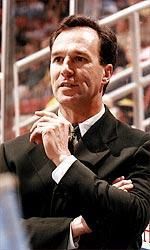Aug. 5, 2004
The Notre Dame Fighting Irish hockey squad moves into the 2004-05 season looking to build on what was the most successful season in the program’s history in 2003-04. Last season, the Irish proceeded where no other Notre Dame team had ever been in the program’s 36-year history – the NCAA hockey tournament. The Irish were 20-15-4 overall and finished 14-11-3 in the Central Collegiate Hockey Association (CCHA), good for a fourth-place tie. Among the teams 20 wins was a 5-1-1 record against team’s ranked fifth or better in the national rankings. The Irish recorded wins over top-ranked Boston College, second-ranked Maine, fourth-ranked Wisconsin and a pair of wins over fourth-ranked Michigan. The Irish were selected to play in their first NCAA tournament and faced two-time defending champion Minnesota in the Midwest Regional in Grand Rapids, Mich. After taking a 2-0 first-period lead, the Irish fell to the fourth-ranked Gophers, 5-2 at Van Andel Arena. Despite the tough loss, Dave Poulin’s icers season can’t be called anything less than impressive. The Irish won 20 games for the first time since the 1987-88 campaign. They finished the season ranked 12th in the national polls. Led by a trio of goaltenders – David Brown, Morgan Cey and Rory Walsh – the Irish recorded the lowest goals-against average (2.48) and the highest save percentage (.925) in program history. Brown set an Irish record with four shutouts in one season and combined with Cey (two shutouts) to set a school record with six shutouts on the year.
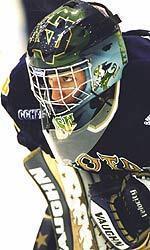
Dave Brown set a Notre Dame record with four shutouts during the 2003-04 season.
|
Defense was the name of the game for Notre Dame in 2003-04. Besides goaltending, the Irish were one of the top penalty-killing teams in the nation. Notre Dame surrendered just 22 power-play goals on the year to set a team penalty-killing mark (.874) that was tops in the CCHA, fourth in the NCAA and best ever at Notre Dame. The Irish also advanced to the CCHA Super Six in Detroit for the third consecutive season and the fourth time since 2000-01. Only Michigan State and Michigan have made it in five consecutive seasons. For Poulin, now in his 10th season behind the Irish bench, the 2003-04 season started with a big question mark in goal as Cey, who had played in 71 of 79 games in his first two seasons, started the year on the sidelines after summer knee surgery. Walsh and Brown would handle the chores even though both had no game experience. Any questions were quickly answered as Walsh and Brown went 5-2 in October with Brown recording three consecutive shutouts (Oct. 18-31). Cey returned to play in two games before going on the shelf again in mid-November and the Irish were 8-6-2 when he returned to the lineup on Dec. 28. He wasted little time getting back to normal as he recorded back-to-back 1-0 shutouts of Maine and Findlay. In January, Notre Dame would go to Madison, Wis., and hand the Wisconsin Badgers, the hottest team in the country at the time, a 2-2 tie and a 3-1 loss. The Irish finished the regular season by winning five of their last six games, including a pair of home victories over Michigan. The 14-11-3 record in CCHA play earned the Irish home-ice in the first round (vs. Western Michigan) of the playoffs for the first time since 1999-2000. The series went to three games with the Irish winning the opener, 4-2 and then dropping game two, 4-0. The deciding game went to overtime and was won by the Irish when freshman Jason Paige whipped a wrist shot past Bronco goaltender Eric Marvin at 12:35 of the extra stanza to send the Notre Dame to Joe Louis Arena and the CCHA Super Six. In Detroit, the Irish season came to a disappointing end with a tough, 6-5 overtime loss to Ohio State as the Buckeyes rallied from a 5-3 deficit to tie the game late in the third period before scoring the overtime game winner. “Last year’s success and making the NCAA tournament for the first time was a huge step for our program. This group of players took us to the next level,” says Poulin. “Now its time to move on to a new season with different challenges. We will continue to work to improve all aspects of the program. The goal remains the same – to be among the top programs in the country.” Poulin and his staff will have a decidedly younger team to work with in 2004-05 as the squad features just four seniors. Lost to graduation are the team’s top two scorers – Rob Globke and Aaron Gill. Defense is where the Irish have their biggest holes to fill as five defensemen have departed – four to graduation – Tom Galvin, Neil Komadoski, Brett Lebda and T.J. Mathieson – and one to injuries – junior Derek Smith – who hasn’t played since January of 2003 due to post-concussion syndrome. In Globke and Gill, the Irish lose a pair of career 100-point players (Globke – 124, Gill, 111). Globke was Notre Dame’s top scorer with 19 goals and career highs in assists (21) and points (40). Included in his 19 goals were five power-play tallies, a short-handed goal and five game winners.
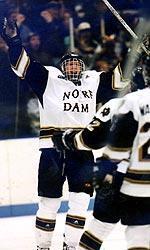
Rob Globke is just one of several noteworthy players the Irish lost to graduation in May of 2004.
|
Gill, the team’s MVP, was second with 17 goals and 21 assists for 38 points, all career highs. The Rochester, Minn., native led the Irish with nine power-play goals on the year. The senior triumvirate of Galvin, Komadoski and Lebda led the Irish defense. The trio logged 20-25 minutes per game and contributed at both ends of the ice. Galvin chipped in one goal and 18 assists for 19 points on the year, playing a steady, consistent style of defense. Komadoski turned in career highs with five goals, 15 assists and 20 points. Four of his five goals came on the power play. Lebda, who led the Irish in shots on goal for three consecutive seasons led the defense in scoring with six goals and 18 assists for 24 points. For the season, Globke, Gill and Lebda were all named second team all-CCHA, the most Notre Dame players ever named to a CCHA post-season team. Mathieson saw limited playing time as a senior and Smith was sidelined by injuries for most of the last two seasons. The five regulars in the Irish lineup all signed professional contracts following Notre Dame’s NCAA appearance. Galvin went on to play for the Atlantic City Boardwalk Bullies in the East Coast Hockey League. Gill played in the American Hockey League for the Cleveland Barons and then was signed by their parent team, the NHL’s San Jose Sharks. Globke signed following the season with the Florida Panthers of the NHL, the team that drafted him in the second round of the 2002 NHL Draft. Komadoski inked his first contract with the Ottawa Senators where he was a third-round draft choice in 2001. He finished the season with the Senators AHL team in Binghamton, N.Y. Lebda was signed as a free agent by the Detroit Red Wings and closed the year with the AHL’s Grand Rapids Griffins. In all, the Irish lose 48 goals (44.4%) and 141 (48.3%) points from the 2003-04 team. More importantly, they lose the experience and leadership of seven players who were key players in the recent success of the Irish both on and off the ice. “Our graduating class played an important role in the recent success of the Notre Dame hockey program,” says Poulin. “That group suffered the growing pains early in their careers and then had the chance to enjoy the success we achieved last year due to their hard work and dedication. They made the decision prior to the start of last season that they were going to have their best year ever and the rest of the team followed their lead,” adds the Irish bench boss. For the season ahead, the Irish return 18 monogram winners from last year’s NCAA team. That includes 11 forwards, five defensemen and three goaltenders. The returning players will be joined by a seven-man freshman class that includes three forwards and four defensemen. “There’s no question that we will be looking to establish our defense first,” says Poulin. “It’s not easy to replace three regulars who played a great deal in their careers, along with a great character guy like T.J. Mathieson. Derek (Smith) also played a lot in his first two years before his injuries, so we have some key holes to fill on defense.” Poulin adds, “The strength of this team will definitely be in goal. With Morgan (Cey) and David (Brown) we have an established duo that may be the premier tandem in college hockey. Rory Walsh gives us a solid third goaltender. He won the starting job last season and was our goaltender on opening night.”
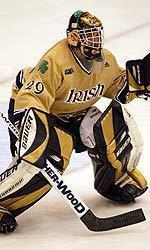
Morgan Cey combines with David Brown to give the Irish one of the top goaltending duos in college hockey.
|
“Offensively, we will be looking for players to step up and take on some of the scoring responsibilities that Aaron (Gill) and Rob (Globke) shouldered. We have some guys who are extremely talented and highly skilled. They just need to show those skills on a consistent basis.” Early in the season, Notre Dame’s success will depend on their goaltenders – Morgan Cey (Sr., Wilkie, Sask.) and David Brown (So., Stoney Creek, Ont.)- until the young defense gets experience at the Division I level. Look for the duo to split playing time in 2004-05 as they did when both were healthy a year ago. Cey played in just 14 games as a junior due to preseason knee surgery and then a follow-up surgery in November. He was 5-7-1 overall while turning in a career best goals-against average (2.42) and save percentage (.924). His back-to-back 1-0 shutouts versus Maine and Findlay gave him a school record six for his career. During his streak, Cey recorded 158:53 minutes of shutout hockey, the second-longest streak in Irish history. In league play, the 6-3, 175-pound puck stopper was just 2-5-0 with a 2.77 goals against and a .904 save percentage. For his career, Cey has played in 85 games, making 83 starts with a 35-36-10 record, a 2.73 goals-against average and a .913 save percentage. Joining Cey in Notre Dame’s one-two goaltending punch is the sophomore Brown. As a freshman, he made the most of his chance to play due to Cey’s early-season injury and quickly took over as the team’s top goaltender in October. After dropping his first start, Brown ran off three consecutive shutouts and set an Irish record with 193:27 minutes of shutout hockey between Oct. 17 – Nov. 8. For his fast start, Brown was named the Hockey Commissioner’s Association (HCA) national rookie of the month for October. On the year, the steady goaltender was 14-7-3 overall, setting Notre Dame single-season marks for the lowest goals-against average (2.32) and save percentage (.925). He also owns the single-season record for shutouts in a season with four. In the CCHA, the 5-11, 188-pound goaltender was 11-5-3 in league play with a stingy 2.19 goals against and a .929 save percentage. A finalist for CCHA rookie of the year honors, Brown capped his first season with the Irish by being selected in the eighth round of the 2004 NHL Draft by the Pittsburgh Penguins. Notre Dame’s third goaltender Rory Walsh (Jr., Milton, Mass.) saw his first career action in 2003-04, playing in three games, making a pair of starts. Walsh was the Irish starter on opening night versus Ohio State; making 31 saves in a 5-2 win against the Buckeyes. In limited action, Walsh was 1-1-0 with a 3.53 goals-against average and a .881 save percentage. Walsh suffered a season-ending injury in early March when he severed an Achilles’ tendon. He is expected to miss the early part of the season recovering from the injury. While the Irish have a solid, veteran duo between the pipes, their defense will be young and inexperienced. The backline features one senior, one junior, two sophomores and four freshmen that will be in the battle for playing time.
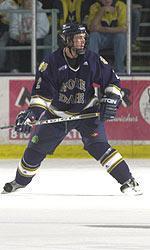
Joe Zurenko will be the lone senior in the 2004-05 Irish defensive line.
|
The lone senior is Joe Zurenko (Palentine, Ill.) who has played in 73 games in his Irish career. Zurenko gives Notre Dame a strong, physical presence on the blue line and is a classic, stay-at-home defender who is strong in the corners and in front of his own net. The 6-1, 205-pound defenseman moves the puck well and is strong on his feet. Zurenko saw action in 23 games last season and recorded no points while picking up 32 minutes in penalties. The lone junior in the defensive corps is Chris Trick (Troy, Mich.). At 6-4, 209-pounds, Trick is a strong skating defensive-defenseman who has made giant strides in each of his first two seasons. A smart, steady defender, Trick keeps the game simple and handles the puck with confidence. In 32 games last season, he had a goal and two assists for three points while picking up 12 penalty minutes. He was +3 for the season with his lone goal coming short-handed. Back for their second season on the Notre Dame defense are sophomores Noah Babin (Palm Beach Garden, Fla.) and Wes O’Neill (Essex, Ont.). Babin saw action in 31 games as a freshman at Notre Dame, splitting time between forward and defense. An outstanding skater with excellent speed, the former Green Bay Gambler and U.S. Under-18 team member showed excellent puck-handling skills with a strong, accurate shot. In 31 games, Babin had one assist and 20 minutes in penalties for the year. O’Neill came to the Irish as a highly ranked junior player and did not disappoint. Playing with three senior defensemen, the former Green Bay Gambler was one of Notre Dame’s top four defensemen and was usually paired with senior Brett Lebda. In 39 games, O’Neill contributed a pair of goals and 10 assists for 12 points and led all Irish defensemen with a +7 plus/minus mark while playing the entire campaign as a 17-year old. Following the season, O’Neill was selected by the New York Islanders in the fourth round of the NHL Entry Draft.
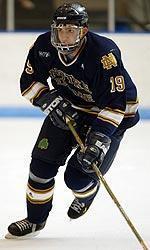
Wes O’Neill will be counted on to provide leadership and experience in the Irish defensive line.
|
In 2004-05, look for O’Neill to be the leader of the Notre Dame defense as he played in all situations last season, including killing penalties and running the power play. He will look to become more of an offensive force on the Irish blue line as the coaching staff will look to replace the offense lost due to graduation. Four freshmen join the Irish defense and will get a chance to play key roles early in the season. Joining the team for their first seasons on the Division I level are Brian D’Arcy (Western Springs, Ill.), Luke Lucyk (Fox Pointe, Mich.), Brock Sheahan (Lethbridge, Alb.) and Dan VeNard (Vernon Hills, Ill.). D’Arcy comes to Notre Dame after playing for the Tri-City Storm of the United States Hockey League (USHL). The 6-2, 205-pound defenseman is known for his aggressive style of play and will give the Irish another physical player on the blue line. He saw action in 32 games for Tri-City in a season cut short by injuries, recording a pair of assists and 36 minutes in penalties. In 2002-03, D’Arcy played in the North American Hockey League (NAHL) with the Cleveland Barons and had three goals and 10 assists for 13 points in 48 games. Lucyk was a teammate of D’Arcy and forward Mark Van Guilder with Tri-City last season, helping the Storm to the USHL regular-season title and a berth in the championship series. A rugged, physical defenseman with solid offensive skills, Lucyk handles the puck well and has excellent mobility. With the Storm, Lucyk had a goal and nine assists for 10 points in 60 games while recording 64 minutes in penalties. In the summer of 2003, he was a member of the U.S. Select-18 team that won the gold medal at the Select-18 World Cup in the Czech Republic where he played for Notre Dame assistant Andy Slaggert. He scored the game-winning goal in the semifinals of that tournament versus Canada. Sheahan comes to Notre Dame after playing last season for the Crowsnest Pass Timberwolves of the Alberta Junior Hockey League. A 6-0, 170-pound left-handed defenseman, Sheahan played in 48 games in 2003-04 with six goals and 22 assists for 28 points. He also racked up 90 penalty minutes while helping the Timberwolves to a 27-29-4 overall mark. An offensive-minded defenseman, Sheahan is a strong skater who likes to join the play and should be a candidate to see time on the Irish power play. A two-year veteran of Canadian junior hockey, he is the most experienced member of the incoming freshmen defenders. VeNard played three seasons of junior hockey with the Green Bay Gamblers where he was a teammate of incoming freshman forward Victor Oreskovich and sophomores Wes O’Neill and Noah Babin. VeNard’s final season with the Gamblers was cut short due to injuries as he played just 22 games with two goals and two assists for four points. A knee injury limited him to just eight games in 2002-03 (1g, 1a) but in his first year as a 16-year old he played in 60 games with three goals and nine assists for 12 points. The 6-0, 175-pound right-handed defenseman is a solid, all-around defender with outstanding leadership skills. He also played on U.S. Select-17 and 18 teams in 2001 and 2002. Offensively, the Irish scored 108 goals a year ago and will look to replace the 36 that belonged to the departed Globke and Gill. Besides those two, three other forwards had 10 or more goals. Poulin believes that he has the players who can pick up the scoring slack and will turn up the production in the season ahead. Of his 11 returning forwards, only two are seniors – team captain Cory McLean (Fargo, N.D.) and Brad Wanchulak (Edson, Alb.). McLean has been a regular in the lineup since his freshman year and turned in a career-best, 10-goal, 14-assist season in 2003-04 and is the team’s second-leading returning scorer. His +10 plus/minus was also second on the team.
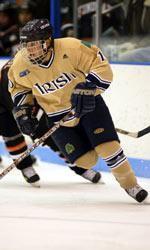
Cory McLean posted a career-best 10 goals and 14 assists in 2003-04 and returns this season as a leader for the Irish scoring line.
|
A strong, two-way player, McLean sees time on the power-play and penalty-killing units and has proven to be a stead, consistent player. A strong leader both on and off the ice, McLean will look to continue to develop the strong chemistry the team had last season. For his career, the 5-9, 170-pounder has played in 113 games with 21 goals and 25 assists for 46 career points. Wanchulak has also seen steady action in his first three seasons for the Irish having played in 103 games at left wing or center. The speedy forward is a strong forechecker who uses his outstanding skating skills to force opponent mistakes at their end of the ice. For his career, Wanchulak has seven goals and 14 assists for 21 points. Four junior forwards will be counted on to take over their share of the offensive responsibilities this season. The group includes Matt Amado (Langley, B.C.), Tony Gill (Rochester, Minn.), Tim Wallace (Anchorage, Alaska) and Mike Walsh (Northville, Mich.). Of the four, Walsh has proven to be a big-time collegiate scorer as he came into his own last season with 12 goals and 13 assists for 25 points. At 6-2, 211-pounds, Walsh blends size, speed and a physical presence to be one of the top power forwards in the CCHA. A New York Ranger draft choice in 2002, Walsh has a nose for the net as four of his goals last season were game-winning tallies. He will also serve as one of the team’s alternate captains this year. Amado and Wallace have played regularly in their first two seasons and will be looking to have break out campaigns in 2004-05. Both have shown flashes of what they can do over the past two years, but will look to become more consistent this season. Amado (6-0, 190) is a left-handed center who has all the tools. Strong on his skates, the talented playmaker can find the open man or create his own shot from anywhere on the ice. As a sophomore, Amado played in 34 games, scoring five goals while setting up seven others for 12 points. Wallace has the size and skill to become a top power forward. A strong, two-way player, he played in all 39 games as a sophomore with three goals and eight assists for 11 points.
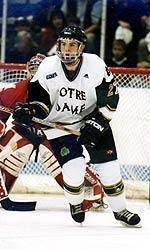
Tim Wallace has appeared in all 79 possible games during his career.
|
The 6-1, 207-pound right wing has played in all 79 consecutive games in his collegiate career. A big year from Wallace in the goal-scoring department will be a key to Irish success in 2004-05. Gill will look to break into the regular lineup this season. A player who provides energy any time he’s on the ice, the 5-10 center is the consummate team player. A strong skater, Gill excels on the defensive side of the game where his non-stop hustle and tenacious forechecking drives opposing puck carriers crazy. Gill saw action in 12 games last season and 15 as a freshman. Five sophomores figure to play key roles on the Irish offense this season. Michael Bartlett (So., Morton Grove, Ill.) played much of the season at left wing, getting six goals and six assists for 12 points in 39 games. An outstanding skater, the 6-0, 193-pound Bartlett has the reputation of being a strong defensive forward and played a key role on the Irish penalty-killing unit. T.J. Jindra (So., Faribault, Minn.) stepped into the lineup and proved to be one of the top penalty killers in the CCHA. He along with Bartlett and Jason Paige (all freshmen) were Notre Dame’s first three forwards on the ice in penalty killing situations. Jindra consistantly came up with big plays with his hard work and hustle. He had four goals and six assists for 10 points in 39 games. Two of his goals came short-handed and two were game winners. Jason Paige (So., Saginaw, Mich.) led all Irish freshmen in scoring with 10 goals and six assists and was one of the top penalty killers. Four of his goals came on the power play and three were game winners. One of the team’s leaders, Paige was selected to be one of the team’s alternate captains as a sophomore. Josh Sciba (So., Westland, Mich.) saw action at left wing and center and may have the most offensive skills of all the sophomores. Blessed with great speed and hands, the 5-11 forward has a nose for the net and makes the most of his scoring chances. In 38 games, Sciba had seven goals and seven assists for 14 points. Matt Williams-Kovacs (So., Calgary, Alb.) played in 25 games as a freshman and contributed five assists. A top scorer in junior hockey for the AJHL’s Calgary Royals, Williams-Kovacs spent most of the season on the fourth line. The Irish brought in three forwards in their freshman class. The trio includes Victor Oreskovich (Oakville, Ont.), Evan Rankin (Portage, Mich.) and Mark Van Guilder (Burnsville, Minn.). All three were big scorers in junior and will have the opportunity to move into the regular lineup. Oreskovich joins the Irish after playing last season for the Green Bay Gamblers where he had 11 goals and 26 assists for 37 points in 58 games. The highly touted right wing was a second-round draft choice of the Colorado Avalanche in last June’s draft. A protypical power forward (6-3, 215), Oreskovich played for the Milton Merchants of the OPJHL in 2002-03 and had 76 points in 49 games and was selected to the Ontario Under-17 team with Irish defenseman Wes O’Neill in 2002-03. Rankin played last season for the Lincoln Stars of the USHL where he was fourth in team scoring with 14 goals and 17 assists for 31 points. A 6-0, 185-pound left-handed center, Rankin scored seven power-play goals and one game winner for the Stars. A member of the gold-medal winning 2003 USA Under-18 Select team with incoming freshman Luke Lucyk, Rankin had three goals and an assist in the tournament, including the overtime, game-winning goal versus Russia. Rounding out the forwards is Van Guilder, a 6-2, 186-pound right wing from the Tri-City Storm. In 60 regular-season games, Van Guilder scored 17 goals and added 22 assists for 39 points in helping the Storm to the USHL’s Anderson Cup (regular-season title). A smart hockey player, Van Guilder has a nose for the net and brings versatility to the lineup as he has played all three forward positions during his junior career. The Irish play an ambitious schedule in 2004-05. It features 17 games versus teams that advanced to the 2004 NCAA Tournament – Minnesota-Duluth (2), Miami (2), Boston College (1), Michigan (4), Michigan State (4), Wisconsin (2) and Ohio State (2). For the 36-game schedule, Notre Dame will play 28 CCHA games, seven against teams from the WCHA, two versus the ECAC and one versus Hockey East. The Irish open the 2004-05 season at home versus NCAA runner-up, Minnesota-Duluth on Oct. 7-8. Notre Dame will also play in three neutral arenas during the year. On Tues., Jan. 18, the Irish will travel to Green Bay, Wis., to face Michigan Tech at the Resch Center. Less than a week later, on Sat., Jan. 22, Notre Dame will play a home game versus Wisconsin at the Allstate Arena in Rosemont, Ill. The last home away from home game will be played on Fri., Feb. 18 when the Irish play host to Michigan at Fort Wayne (Ind.) and the Allen County War Memorial Coliseum.







